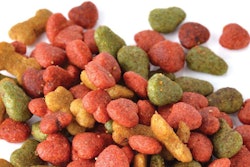
Katy Nelson, veterinarian and host and executive producer of “The Pet Show with Dr. Katy,” challenged attendees at Petfood Forum 2019 to three ways they can help strengthen the human-animal bond while improving the health status and lives of pets.
Nelson was the keynote speaker at Petfood Forum on Tuesday in Kansas City, Missouri.
“By changing how we think about feeding, we can change the lives of our pets,” Nelson said.
Challenge No. 1: Find a way to honor the human-animal bond
“If you can give pet owners a way to enhance their bond at every single meal, we can change the lives of pets,” Nelson said.
By providing pet owners with the best nutrition for their pets to feed at every meal, pet food manufacturers can encourage pets’ long lives and optimal health.
But pet owners need better information so they can learn how to feed their pets in the best way. The desire of pet parents to feel a bond while feeding their pets has, in many cases, resulted in high rates of overweight and obese pets, Nelson said.
“We are shortening the lives of our pets,” she said. “We are killing them with kindness.”
Because people bond over food, Nelson said pet owners need a way to also bond with their pets at meal time while enhancing their pets’ health.
“We’ve got to reinvent the experience of feeding our pets,” she said. “We’ve got to make (pet owners) feel a connection.”
To do that, pet food manufacturers can provide consumers with pet food labels they can understand, with ingredients that use sustainable sourcing and are humanely raised and that make the least environmental impact.
“People want to feel good about what they’re feeding,” she said. “You can make a huge change in how your customers feel.”
Video: How nutrition, health impact the human-pet bond
The feeding experience needs to be reinvented, so pet owners’ bond with their pets at every meal instead of throwing some kibble into a steel bowl, which isn’t very satisfying for owners. As a result, owners overfeed pets with food and treats to achieve that bonding experience, Nelson said.
Challenge No. 2: Stop with marketing trends
“Pets are not small people,” Nelson said. “They don’t need the trends. They need good, solid nutrition.”
Nelson challenged the pet food manufacturers in the audience to stop catering to human food trends and to provide high-quality foods that contain the nutrition pets need.
“We need to stop giving people what they think they want, educate them on what they actually need and give them what their pets actually need,” she said.
Nelson also asked manufacturers to do research and release the results so veterinarians and pet owners can understand how things are changing in pets.
“Tell us what we need to know in order to be your best ally,” she said. If veterinarians have good information backed by research, then they can recommend the right foods to their patients.
Nelson said veterinarians and consumers need more variety in flavors for prescription diets, especially for cats, unique protein and carbohydrate sources for pets with allergies, and fewer unnecessary fillers, dyes and preservatives.
“We need to change more than what’s on the outside of the bag,” she said. “We need to change what’s in it as well. We need to improve what’s in it.”
Challenge No. 3: Question the status quo on pet food labels
“We’ve got to shake up the pet food label,” Nelson said, adding that there is a need and the capability to provide more than just generic feeding information on pet food labels. This includes feeding guidelines for pets at various nutritional milestones or with certain diseases or body condition status.
“Our pets are in crisis and it is time to make a real change in how we are making recommendations for their food,” she said.
Because 80 percent of American dogs and 90 percent of American cats are spayed or neutered, the resulting metabolic change means those animals have different nutritional needs.
“Cats only need about 75-80% of the food that they were eating prior to being spayed or neutered in order to maintain an optimal body weight,” she said.
Nelson added that pet food labels need to be redesigned to be easier to read, simplified, and contain real feeding guides for real pets, as well as information on where consumers and veterinarians can go online to get more information that doesn’t fit on the label.
“Give us some relevant feeding recommendations for our pets,” she said. “The futures of our pets depend on you and they depend on making change and doing the right thing.”
Video: Why pet food companies, veterinarians should collaborate
Many consumers believe pet food companies pay veterinarians to endorse certain dog and cat food diets to clients and this simply isn’t true, Nelson said. However, pet food manufacturers and veterinarians should collaborate more on pet nutrition to help them understand the formulations to recommend the best diets for a pet’s specific needs.













